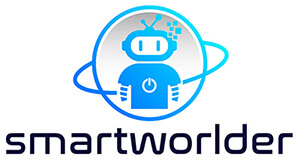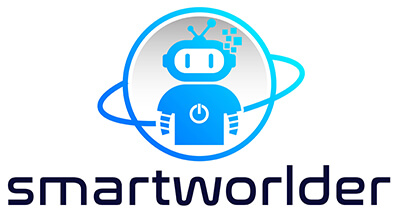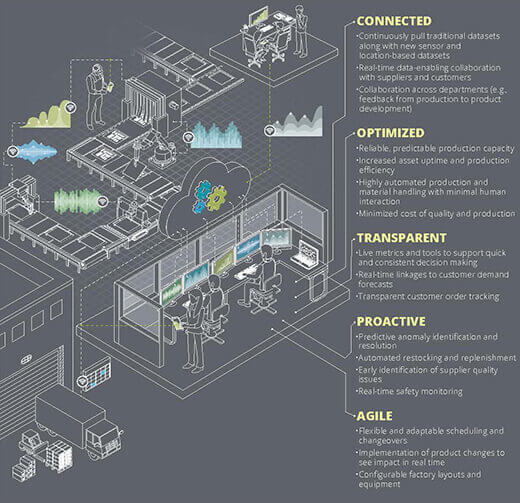What Is Smart Technology?
Content
It seems that nowadays everyone has a smartwatch and smartphone, and lives in a smart home that is in a smart city. Every other service and product is 'smart' or 'intelligent' and they have started flooding our lives – undoubtedly the label 'smart' is abused in a not insignificant way.
There is no clear-cut definition of what a smart device is; it definitely is not a technical term. A lot of marketing hype has resulted in misconceptions that anything that contains a computer chip or has some preprogrammed functions is smart.
For the purpose of our article we use this definition: Smart technologies refer to various devices, systems and applications that utilize artificial intelligence, internet connectivity and other advanced technologies to enhance and automate various tasks in various fields such as home automation, transportation, healthcare, security, etc. Examples include smart home devices, smart cities, smart cars, wearable technology and smart healthcare devices.
In general use, smart technology is grouped into three areas:
Internet-of-Things (IoT) devices.
Smart connected devices. Examples are smart security cameras, smart bulbs, and smartphones.
Unconnected smart devices. Here, ‘smart’ simply refers to the fact that these devices can be programmed to perform certain tasks, like a coffeemaker starting to brew your favorite cup of joe at 7 o’clock in the morning.
It’s also important to note that smartness is not a categorical attribute of a technology, as there are different levels of being smart. It depends on the degrees of freedom that are programmed into a system and the complexity of the environment that surrounds it. How difficult it can be to achieve smart objects is evidenced by the growing pains of self-driving and fully autonomous automobiles.
Another critical differentiation involves the terms automation and autonomy. A simple and a smart thermostat both display automation, but their level of autonomy differs – the smart thermostat has a broader palette of goal-oriented behavior due to its learning capacity.
The difference between automation (which does not imply agency) and autonomy (which does) is usually sought in the ability of a system to respond to its environment in a way that sustains its own endurance and prevents or repairs failure modes, notably in the face of uncertainty.
Originally, the term ‘smart’ was used as an abbreviation for Self-Monitoring Analysis and Reporting Technology. That has morphed into its actual meaning of clever or intelligent to describe any kind of device that is capable of connecting with internet networks and thus connect with other devices or remote databases. But the simple fact that a device is connected to the Internet or can send and receive information doesn’t make it smart yet.
From the first ‘thing’ connected to the Internet to 75 billion IoT devices in 2025
Before we delve into smart technologies, we need to tackle another big buzzword: the Internet-of-Things, or IoT. (read our explainer on the Internet-of-Things here)
The first 'thing' on the Internet was created in 1982: a soda machine at Carnegie Mellon University in Pittsburgh, Pennsylvania, that reported on the number and the temperature of the drinks it contained.
In 1999, British technologist Kevin Ashton came up with the term Internet of Things to define a network that not only connects people, but also the objects around them – like that Coke machine at CMU. At the time, most people thought this was the stuff of science fiction films. Today, the IoT has become a reality, thanks to the development of communication technologies, big data analytics, and ever more sophisticated algorithms.

At some point in 2008 or 2009, the number of things connected to the Internet came to exceed the world’s human population. Since then, the IoT has become a vast network of connected objects collecting and analyzing huge amounts of data and autonomously performing tasks. An estimated more than 35 billion devices will be connected by the end of 2021 to this data network worldwide – sensors, household appliances, machines, wind turbines, medical devices, TVs, watches, cars and much more.
According to predictions, the number of IoT connected devices will grow dramatically to 75 billion in 2025 and a staggering 125 billion by 2030. At that point, there will be almost 15 things connected to the Internet for each human on earth.
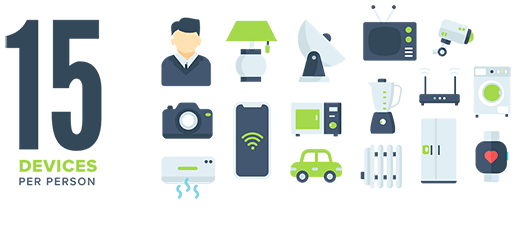
However, the main factor of this growth is not the population of the world but the explosion of connected devices.
Successful IoT devices will integrate seamlessly into our lives and our homes until we forget that they are there and that we once did these tasks manually. Opportunities arise from invisible hardware which works (together) autonomously, automatically adjusts settings or intuitively via voice control.
How Does Smart Technology Work?
Smart technology relies on smart devices that are equipped with one or several sensors that provide data that they use to analyze and infer from, drawing conclusions from preprogrammed rules, confer with other smart devices, and act accordingly. To do that, they also need a certain amount of computing power, one or more actuators, and communication capabilities (such as Bluetooth or Wi-Fi).
Some smart devices are also capable of learning by using experience to improve performance, anticipating, thinking and reasoning about what to do next.
The sensors that smart devices can be equipped with can perform all kinds of measurements – temperature, acceleration, radiation like light intensity, humidity, motion like heartbeat, pressure, and so on – so there really is not limit as to the application areas where they can be used.
This combination of sensor data, interconnectivity and learning gives smart devices a certain degree of autonomy – and that improves their performance when compared to their non-smart counterparts.
An additional component that is common in many smart devices is an app that allow the user to control them by voice or finger tap on a touchscreen. Quite often, these apps are linked to an external service provider. An example of such a service provider would be Amazon when using Amazon’s Echo home assistant devices or Apple when using Siri on a HomePod.
When smart devices are grouped with other smart devices in a network then you also hear the term smart network or smart grid. These cooperating devices can check system status and any change of environmental parameters affecting the entire system and decide whether to act on them or not (for instance shutting down a pipeline if a leak is detected; or tapping reserve power generators if a higher than anticipated electricity demand is noticed somewhere in the electrical grid).
In the following we will look at some examples of smart technologies.
Examples of Smart Technology for Individuals – Consumer IoT
The most common areas where a person comes in touch with smart technology is in the home or through wearables.
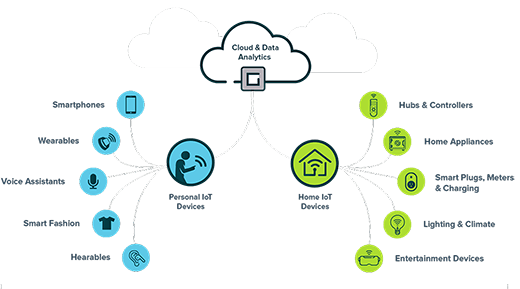
Smart Home Technologies
Smart home technologies broadly fall into one of 3 categories: security, convenience and entertainment. They include many aspects of home monitoring and control: access control (smart locks); fire, gas and water leak detection; temperature monitoring; convenience and improved energy efficiency through lighting control, heating and air conditioning control; automated meter reading; automated entertainment control.
Among other things, smart, interconnected technology saves energy and makes the home more secure. It catches water leaks before they become disastrous. It makes kitchen and housecleaning chores easier. And it changes up lighting and entertainment options to match moods.
A great example of smart home technology are thermostats like Google’s Nest. This is an electronic, programmable, and self-learning Wi-Fi-enabled thermostat that optimizes heating and cooling of homes and businesses to conserve energy.
The device is based on a machine learning algorithm: for the first few weeks, users have to regulate the thermostat manually in order to provide the reference data set. The thermostat can then learn the residents’ schedule, at which temperature they are used to and when. Using built-in sensors and phones' locations, it can shift into energy saving mode when it realizes nobody is at home.
The Nest infrastructure includes temperature sensors, cameras, smoke and carbon monoxide detectors, and can connect to your water heater and environmental controls for heating and air conditioning.
Not all is rosy, though. Consumers who purchase a variety of different smart devices produced by a range of developers will likely face problems when they try to get these solutions to work together, or to respond to a single unified command system. Other challenges include guarding against security risks in the form of malicious hackers attempting to gain access to the system or individual devices like a child’s smart toy.
Smart Wearable Devices
Wearable devices are now at the heart of almost every discussion related to the Internet of Things (IoT). Health & fitness oriented wearable devices that offer biometric measurements such as heart rate, perspiration levels, blood pressure and even complex measurements like oxygen levels in the bloodstream have become available.
Smart watches, fitness trackers, smart garments, smart medical attachments, data gloves – the market for wearable electronics is quickly evolving beyond health care, fitness and wellness into infotainment, and commercial and industrial applications. Wearable electronics consists of several areas: sensors, actuators, electronics and power supply or generation.
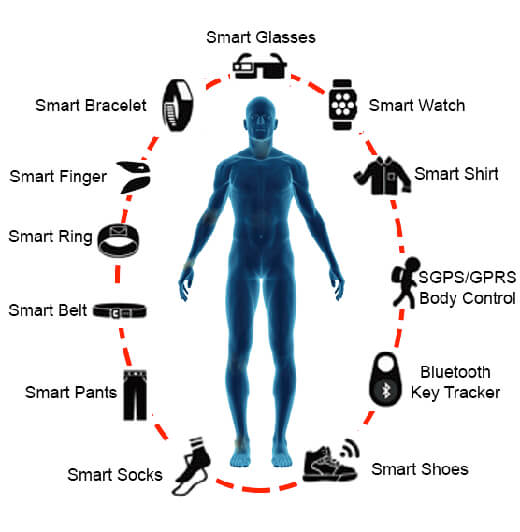
Whereas the first generation consisted mostly of detachable components – watches, armbands, rings, attachable sensors – the second generation is moving towards textile-embedded sensors in smart clothing, actuators, and therapeutic solutions. These can be truly called wearable electronics.
Smart contact lenses are already in development. They will enable various point-of-care monitoring and wireless biomedical sensing, which may detect in real time the pathogen, bacteria, glucose, and infectious keratitis present in tear fluid. One example is a recently developed sensor for diabetic and glaucoma diagnosis.
Smart Technology for Industry
Businesses in many industries – manufacturing, real estate, mobility, agriculture, retail, service, and other sectors – use IoT toward a wide variety of objectives and tasks. Businesses are using sensors to track and manage inventory. They are integrating IoT-based monitoring to optimize operations – from maintaining equipment to re-designing processes and spaces. Businesses are using IoT to ensure efficient use of energy and monitor and mitigate security risks. They are using IoT to identify dangers to worker health and safety, and to manage and enhance employees’ performance.
Smart Factory
The basic smart technologies enabling a Smart Factory are not that different from a smart home – sensors, actuators, computer processing, algorithms and connectivity. But that’s where the similarities end. Modern factories are highly complex systems with sophisticated processes and requirements.
The smart factory represents a leap forward from more traditional automation to a fully connected and flexible system—one that can use a constant stream of data from connected operations and production systems to learn and adapt to new demands.
A commonly accepted definition of a smart factory is a flexible system that can self-optimize performance across a broad network, self-adapt to and learn from new conditions in real or near-real time, and autonomously run entire production processes. The benefits are greater asset efficiency, lower cost, better quality, and enhanced safety and sustainability.
Enabled by sensors, sophisticated data processing and interconnected components allow an environment in which machines, single modules, entire systems, products, materials and humans organize themselves to optimize throughput with efficient resource usage.
Smart factory systems even allow for direct communication between the product (work piece) and the production system: the product contains all the necessary manufacturing information in electronic form with it, i.e., on an RFID chip. Based on this data, the way of the product through the complete production chain can be tracked and traced.
Smart Logistics
Tracking and tracing then continue through the logistics chain, warehousing, and the way to the end user. Smart logistics can be defined as the effective use of data for structuring traffic management and navigating traffic for optimal use of traffic system and logistics management (organizing, planning, control and execution of the flow goods).
Smart logistics can be applied to public traffic networks like managing inner-city or highway traffic. Most commonly though, it refers to solutions that improve efficient commercial transport and warehousing, and the facilitation of (inter)connectivity between different logistics networks, for example for the exchange of transport orders between different parties and/or modalities.
Smart Agriculture
An important area for smart technologies has emerged in an area you don’t immediately associate with leading-edge technologies – agriculture.
Smart agriculture, or smart farming, is driven by the rapidly rising use of IoT sensors to turn every element and action involved in farming into data. This data can be supplemented by remotely collected data such as aircraft and satellites. One of the fundamental differences between traditional and smart farming is, apart from the mechanization level, the data collected directly from the crops.
In traditional farms, where growers judge by visual assessment, decisions are relative and subjective. Smart farming offers assessment by quantitative data producing objective decisions that can autonomously acted upon by field systems and robots (watering, use of fertilizers, automatic differential harvesting, etc.).

Smart Technology in Healthcare
Health service systems are another area where smart technologies will have significant impact. Smart healthcare uses technology such as wearable devices, IoT, and mobile internet to dynamically access information, connect people, materials and institutions related to healthcare, and then actively manages and responds to medical ecosystem needs in an intelligent manner.
Smart healthcare can promote interaction between all parties in the healthcare field – patients, doctors, hospitals, insurers, laboratories, research institutions, government agencies – to ensure that participants get the services they need, help the parties make informed decisions, and facilitate the rational allocation of resources.
Smart healthcare includes functions like disease prevention and monitoring; diagnosis and treatment; smart hospital management (services for medical staff, for patients, and for administrators); patient data management; agency reporting; health decision-making; and medical/pharmaceutical research.
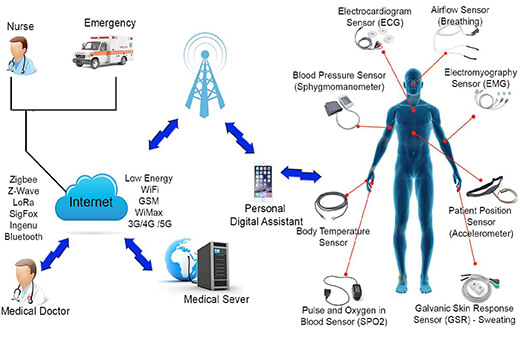
Smart Technology Serving Society – Smart Cities
The above examples showed the use of smart devices for individual users and for industry. But smart technology also plays a huge role in government, infrastructure and civic environments – the buzzword being Smart City.
Utilizing environmental sensors, satellite data like GPS, utility meters, counters, cameras, and other connected devices has given cities more expansive data at an unprecedented scale. Cities are using these data to measure environmental conditions, set goals, and manage interventions that result in improvements for residents. They are tracking their fleets to optimize operations and implement preventive maintenance. They are monitoring the use of energy and water to increase efficiency. They are analyzing the flow of people to better plan public space.
When used in a collaborative environment, smart technologies allow sensors, databases, and wireless access to work together to sense, adapt, and provide for users within the environment.
A smart city is a framework that embraces information and communication technologies to develop, deploy, and promote sustainable development practices to address growing urbanization challenges. A big part of this framework is an IoT network of sensors and machines throughout a city’s infrastructure and services.
Cloud-based IoT applications receive, analyze, and manage data in real-time to help municipalities, enterprises, and citizens make better decisions that improve quality of life.
Citizens engage with smart city ecosystems in various ways using smartphones, connected cars, and their homes.
A smart city infrastructure helps a community to improve things like energy distribution, streamline trash collection, decrease traffic congestion, and improve air quality. For example:
Sensors embedded in roads, streetlights, traffic lights, and cars continuously send data that allows monitoring systems to change traffic light cadence and timing to respond to real-time traffic, reducing road congestion.
These sensor networks also accurately monitor environmental conditions like air quality, water runoff, fires, or even wildlife count.
Sensors will also allow structural health monitoring of infrastructure such as building, roads, dams and bridges.
Connected cars can communicate with parking meters and electric vehicle charging docks and direct drivers to the nearest available spot.
Smart garbage cans automatically send data to waste management companies and schedule pick-up as needed versus a pre-planned schedule.
A smart utility grid empowers end users to be more aware of their energy uses and allow utility companies to deliver only as much energy, water or gas as is needed.
Smart buildings utilize monitoring services that track usage to optimize electricity demands.
Citizens’ smartphone becomes their mobile driver’s license and ID card with digital credentials, which speeds and simplifies access to city and local government services.
Check out our SmartWorlder section to read more about smart technologies.

